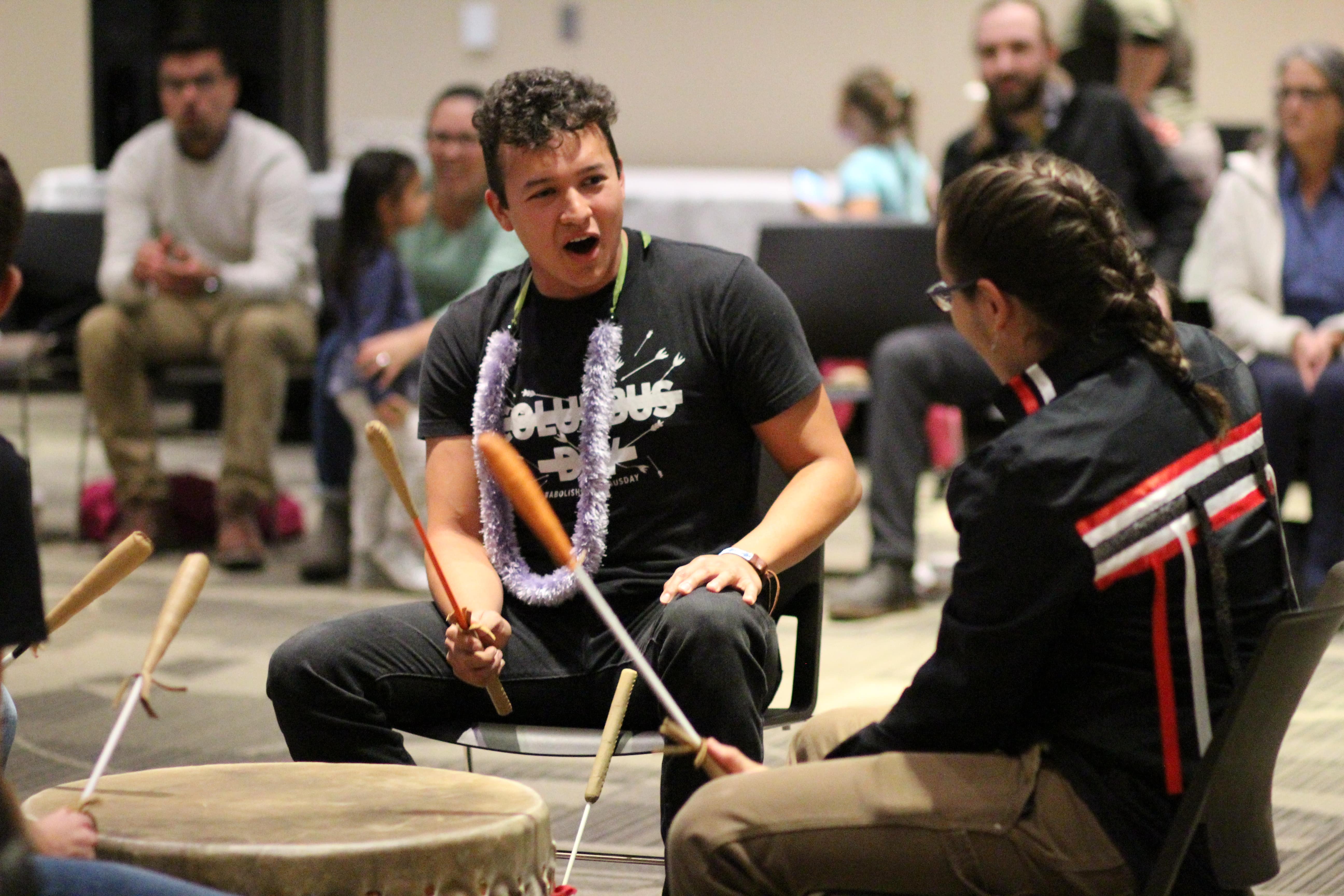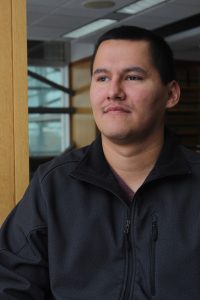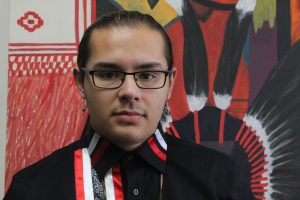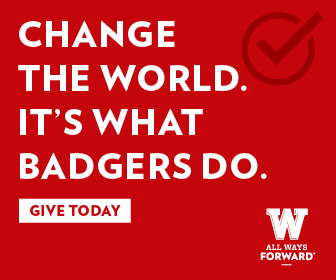Hold Your Ground

Hold your ground
Lack of representation brings Native American law students to the stand
Forrest Gauthier didn’t tell the members of his tribe he was considering law school.
They were the reason he was doing this. They were the ones who had taught him how to hunt and fish, and to give much of his haul to those who could no longer bring home their own. It was they who had once created such a thriving economy that the U.S. government stopped recognizing the tribe, a decision that for more than 10 years prevented new members from enrolling.
And it was their grocery store and hospital that disappeared in the following decades, along with about a third of the reservation’s population. It was this tribe — his tribe — that had become Wisconsin’s poorest; in their county, where 87 percent of residents identify as Native American, more than 35 percent live below the federal poverty line, almost triple the rate for the state as a whole.
He didn’t doubt their support. But back home on the reservation, about 60 miles northwest of Green Bay, just going to college was an outside-the-box choice, and no one else from his generation — as far as he knew — had considered law school.
“The whole time that I was studying for the LSAT, I didn’t tell anybody what I was doing,” says Gauthier, a towering and soft-spoken 27-year-old and former three-sport athlete for Menominee Indian High School.
So he waited until he’d taken the entrance exam, until he’d seen his score and gauged his chances of success, to begin breaking the news to his community, the Menominee Indian Tribe of Wisconsin.
“They were very supportive. They’re like, ‘That’s great,’ because we don’t know [many] Native attorneys from my community,” Gauthier says. “It provides me some reassurances that it was the right decision and that people are supporting me on this journey” — he laughs — “because law school’s hard.”
When Gauthier enrolled at the University of Wisconsin Law School in 2018, he was one of nine Native American students and one of only about 200 Native American students in the country embarking on a legal education that year, according to statistics compiled by the American Bar Association. 
Unreliable data make it difficult to measure Native American representation in the legal field, as many people who are not enrolled members of tribes check the Native American box on forms. The gap is large: On the 2010 U.S. Census, 5.2 million people selected American Indian or Alaska Native as one of their races, but in the same year, just under 2 million were enrolled as members of federally-recognized tribes. Law schools are not required to ask applicants who identify as Native American to describe their ancestry or tribal affiliation, though the American Bar Association has recommended that they do so.
But one thing is clear: Native Americans make up a tiny fraction of the legal profession. In 2018, they were only 0.5 percent of new law students, and in the 20 states that reported demographic information to the American Bar Association, Native Americans made up only 0.5 percent of lawyers.
The numbers are no more promising at the top of the ranks. The first Native American federal judge was appointed in 1979. In the 40 years since, the number serving at any time has never exceeded two.
Tribes need more Native American lawyers, advocates say, to navigate emerging legal complexities and continue longstanding battles for rights. Without them, tribes may find themselves without sufficient and culturally appropriate defense as legal matters come to the fore, such as treaty rights, the Indian Child Welfare Act, the casino industry or even possible representation in Congress.
High stakes
While people of all backgrounds choose careers in law, Native Americans may choose that path for different reasons than their non-Native American peers.
According to the 2018 results of the American Bar Association’s annual survey of law students, the most common reasons law students gave for their career choice were that they were seeking “careers in politics, government or public service,” that they were passionate about the work itself or that they were seeking “an opportunity to be helpful.”
For Native American law students, the stakes are much higher.
“With the Native community … the legal rights of that community are critical to survival in a way that I don’t think that other people can truly appreciate,” says Stacy Leeds, a citizen of the Cherokee Nation and former dean of the law school at the University of Arkansas. “We need a lot of people who are trained to be able to advocate for us, and … when those people also are from those communities, there’s a passion and a personalization that can’t be replicated.”
Law comes calling

University of Wisconsin law student and member of the Menominee Indian Tribe of Wisconsin Forrest Gauthier sits in one of the law libraries.
It wasn’t until Gauthier left the Midwest that the lifelong Wisconsinite realized that law school was for him. In fact, when he graduated from UW-Madison, he thought he was done with school for good.
“I didn’t really think beyond undergrad,” Gauthier says. “My thought at that time was like, ‘This is a huge accomplishment for me, and this is where it ends.’”
From Madison, Gauthier returned to his reservation in northern Wisconsin and worked on an obesity prevention effort for his tribe before moving to New Mexico, where his partner was working toward a doctorate. It was there, nearly a country’s width away, that he saw Native Americans in the Southwest grappling with many of the same challenges his Wisconsin tribe faced, and he realized that a law degree might position him to help.
Fortunately for Gauthier, he happened to live next to a university that houses what has been called the most successful pipeline program for Native American law students in the country. In summer 2018, he joined Native American prospective law students from across the country at the American Indian Law Center, housed at the University of New Mexico, for the Pre-Law Summer Institute. The eight-week intensive preparation program is designed to mimic the first semester of law school.
A partner on the journey
At the summer institute, Gauthier met Lorenzo Gudino, a baby-faced, self-described “urban Indian” who jokes that he looks too young to have a Costco card. Gudino is a member of the Fort Sill Apache Tribe of Oklahoma, but he grew up in the Chicago suburbs, far from the rest of his tribe. Gudino’s mother and grandmother had worked at Chicago’s American Indian Center and would regularly bring him along with them, but at school, he and his brother were the only Native Americans.
Gudino earned a bachelor’s degree in journalism from Northwestern University and reported for seven years on Native American communities, but he ultimately decided he wanted “to do more” with the stories he was hearing. During college, he attended a talk by a Native American lawyer and recalls turning to his mentor, Douglas Medin, professor emeritus of psychology at Northwestern University, as soon as the speaker finished.
“Are you thinking what I’m thinking?” Medin asked.
“Yeah, I think so,” Gudino said. “I think this is the way we have to make this next step.”
Three years later, he was in New Mexico preparing for the journey.
Because many students were still awaiting admissions decisions, students at the summer institute were told not to discuss what schools, if any, had accepted them for admission. But when Gudino discovered Gauthier would be his classmate at UW-Madison, he was thrilled.
Not a thing of the past
While many Americans might have only ever learned about treaties and Indian law from history textbooks, Gudino says it would be a mistake to think of them as relics of the past. “America is still a very relatively young, growing country,” Gudino says. “A lot of the same issues that it was grappling with, we’re still grappling with.”
Today, legal issues related to Native Americans can be found on court dockets all the way up to the highest court in the land. In June, the U.S. Supreme Court announced it would hear for a second time a case that could determine whether about half of Oklahoma is, in fact, still Indian Country. Many argued that at the heart of the push for the Dakota Access Pipeline and the ensuing protests at Standing Rock were questions about what water and land rights tribes reserved in their treaties and whether those treaties were fair in the first place. Treaty rights made headlines again in September of this year when the Cherokee Nation named Kimberly Teehee its first delegate to the U.S. House of Representatives. An 1835 treaty promised the tribe a nonvoting congressional delegate, but the position had never been filled. Teehee’s appointment is currently awaiting congressional approval.
A call for more native lawyers
A little more than a year after meeting in New Mexico, Gudino and Gauthier are classmates in a course on federal Indian law. Their professor, Richard Monette – now the director of the university’s Great Lakes Indigenous Law Center – enrolled in law school more than three decades ago for reasons not so different from theirs. Growing up on the Turtle Mountain Band of Chippewa reservation in North Dakota, Monette says, it was hard to ignore the disparities between life on the reservation and the “surrounding society.” He found motivation, he says, in the “cacophony and some of the dissonance” between his world and the worlds around him.
“On rare occasions, you feel like you’re coming out ahead, but frankly, most of the time you feel like you’re coming up behind. And you feel like it’s unfairnesses that can be addressed in the law, and sometimes they can,” Monette says.
For decades, Monette has made meeting the legal needs of Native American communities part of his law school job. He and his students have provided legal expertise and mediation to aid tribes in drafting constitutions that conform to their own values. His team drafted the Ho-Chunk constitution that was adopted in 1993, and others are pending.
Perched on a plush bench in a hall of UW-Madison’s historic Memorial Union, Monette speaks enthusiastically about the opportunity to develop the Native American lawyers of the future.
His “charge” at the moment, he says, is to convince students to become lawyers in the “old fashioned lawyer-in-town sort of model” in Indian Country, rather than exclusively pursuing careers with tribe’s casinos or marijuana operations. Tribes need more Native American lawyers, Monette says, to help with everything from ensuring casino operations align with the community’s priorities to drafting new constitutions and settling property disputes.
In some cases, that means writing new laws, and he argues that Native American lawyers “steeped in the culture” are uniquely qualified to ensure that, even as the dressings of justice might come to resemble those of the U.S., the tribal values remain front of mind.
“It’s okay to call them laws… It’s okay to call it a courthouse,” Monette says, and it’s fine if the courthouse is made of marble pillars and glass. “None of that matters. You could be wearing black robes, little curly white wigs,” Monette says. “What matters is that the norms and values, the culture, that is giving life to the laws there … is ours. That’s what matters.”
Creating a new wave
Monette and Leeds belong to what Leeds calls “this first 50 years’ wave” of Native American lawyers, who were growing up just as tribal governments were regaining strength in the 1970s. Those lawyers tended to study federal Indian law, becoming what Leeds calls “generalists.”
Now, Leeds says, it’s time for some future Native American lawyers to specialize in areas such as banking, intellectual property or education. That might mean recruiting people whose first passion isn’t the law — for example, an education advocate in Indian Country might find that navigating the complex tribal educational landscape requires a law degree, Leeds says.
“There’s almost nothing that a tribal community does that isn’t political and doesn’t have complex legal issues associated with it,” Leeds says.
After 28 years at UW-Madison, Monette speaks frankly about his university. He notes that 20 years ago, the school enrolled far more Native American students than it has in recent years. In the late 1990s, the Native Americans share of the law school student body was double what it is today.
Among Monette’s recommendations: offer more funding to Native American students, perhaps by partnering with tribes. He’d like more opportunities for Native American students, including undergrads, to participate in the work the university does with tribes. He’d also like to see the university and law school coordinate with tribes to create opportunities for law students to clerk for federal, state and tribal judges and then get jobs in courts or government after graduation.
Waiting in the wings

Michael Williams, dressed in his casual traditional clothing, stands in front of a mural in the American Indian Student & Cultural Center.
On a chilly October evening at UW-Madison’s Dejope Residence Hall — named for the Ho-Chunk term for “four lakes” — Gudino and three fellow students surround a large drum, taking turns beating the drum and singing powwow songs from area tribes. The four sit in the center of the large room as dancers in tribal regalia circle them in dance. It’s a celebration of Indigenous Peoples’ Day, which Native Americans and their advocates believe should replace Columbus Day. At Gudino’s left sits Michael Williams, 21, a leader of campus Indigenous student organization Wunk Sheek and an organizer of the evening’s festivities.
If Williams has his way, he and Gudino may soon share more than a drum. A UW-Madison junior studying psychology, legal studies and American Indian studies, Williams hopes to be part of a future class of law students and eventually return to help his tribe, the Oneida Nation, with its legal matters.
“I think about my tribe because they’ve helped me do everything so far in my life,” says Williams, who grew up around 50 miles from Gauthier on the nearby Oneida reservation. “I want to be back in my community, and I want to be making it better and making it sustainable for not just me, but for the next generations to come as well.”
UW-Madison is one of the top schools on his list; he’d like to be able to intern with his tribe. One day, he hopes, he’ll be the one encouraging the next generation of lawyers. “What I envision is to kind of be that named person that people know, that you can say, ‘Oh, this kid who is my friend’s daughter … is interested in law, you should go and talk to Michael.’ I want to be that name in the community that people can be comfortable with, and that people can come and talk to,” Williams says.
“Obviously, I have a lot of work before I can get there,” he adds. “But that’s always the goal — is just to help the people after you.”

